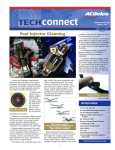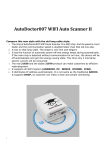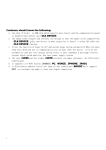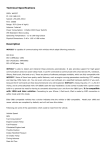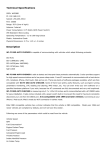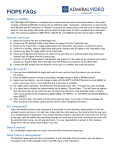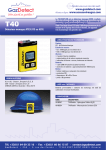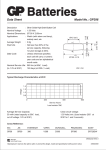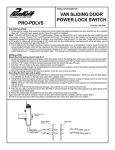Download Rattler® Instructions
Transcript
THE Rattler ® 870001 870006 870012 870019 61/4" SB Chevy 8" BB Chevy 71/4" SB Chrysler 61/4" V6 Buick Stg. II 870002 870007 870014 870022 71/4" SB Chevy 65/8" SB Ford 71/4" SB Ford 61/4" V6 Chevy 870008 870003 8" SB Chevy 1 7 /4" BB Ford 870015 1 7 /4" BB Chrysler 870024 1 6 /4" Oldsmobile w/ GM pulley pattern 870004 870009 870017 870025 61/4" BB Chevy 71/4" BB Chrysler 61/4" 4 Cyl. Pontiac 61/4" SB Chevy w/ BB hub 870010 870005 1 7 /4" BB Chevy 1 6 /4" SB Ford The high performance automotive industry has been borrowing aviation technology for years to craft lighter, stronger and faster vehicles. TCI ® Automotive has been awarded a US patent for applying aeronautical torsional vibration control technology to the automotive engine balancer. Much like its namesake, the Rattler® will emit an audible warning that it's ready to strike down its enemy, torsional vibration. What makes the Rattler® so deadly is its ability to accurately absorb and eliminate vibrations via energy dissipation and dampening usually by converting the energy to heat. Working closely with Roush Anatrol of Livonia, Michigan, the design was perfected and compared to the leading competitors' products in a series of controlled dynamometer and on track test sessions. Tests prove that the Rattler is the hands down leader in torsional vibration control when compared directly to the fluid elastomer designs currently on the market. The Rattler® consistently demonstrated less amplitude of vibration and degrees of crankshaft twist than the others designs. The Rattler® is constructed to exacting tolerances on CNC equipment to ensure that all production units perform with 870018 1 6 /4" V8 Pontiac 870054 1 6 /4" BB Chevy the desired levels of performance and durability. Because the timing marks are integral to the Rattler® body, they can never move relative to the crankshaft. The Rattler® has also passed the high-speed spin tests required to meet SFI Spec 18.1 required for many competition vehicles. In fact, TCI® subjected the Rattler® to an additional, non-required, extreme imbalance high-speed spin test to further ensure the reliability and safety of the product. The effectiveness of TCI®'s Rattler® is a constant for all engine speeds, making it suitable for all forms of motorsports and performance vehicles. In fact, the Rattler®'s test results were so amazing that it piqued the interest of prominent NASCAR, NHRA and IHRA professionals. They know that the added durability and potential power gains, due to valve train stability, could provide a distinct advantage to help place them in the winner's circle. • Accepts standards pulleys and crank triggers. • No fluids, elastomers or friction materials to depend on. • Reduced crankshaft fatigue over all current designs. • Maintains maximum effectiveness at all engine speeds. Installation Instructions Before you can begin installation of the TCI® Rattler®, you should obtain all necessary components needed during installation. You will need a balancer installation tool (saves time and decreases the chance of damage to the crankshaft snout or damage to your TCI® Rattler®) and anti-seize compound. You will also want to check and replace these components if necessary: crankshaft bolt and crankshaft key. STEP 1 If you are not installing on a new crankshaft, remove the old balancer. Next, inspect the crankshaft snout for nicks and/or burrs then remove key and inspect surface around the keyway slot. Check the area making sure that it is free of dirt and debris. Check keyway for proper fit. Prepare the crankshaft by using a file and/or emery cloth to polish the surface to a smooth finish. Clean thoroughly before installing a new Rattler®. IMPORTANT: Proper fit for your Rattler® is an interference fit of between 0.0005" and 0.0008". If your crankshaft snout is too small to achieve the specified fit you may experience galling problems. Please verify that the outer diameter of your crankshaft snout is to spec. STEP 2 After you have inspected and prepared the crankshaft, you are ready to install your new TCI® Rattler®. Using anti-seize, place a small amount on the crankshaft snout and inside the Rattler® opening. Thoroughly coat both surfaces. This will allow the Rattler® to go on smoothly over the crankshaft without galling. STEP 3 870008 Only - To install this unit on 332, 352, 390, 427 and 428 'FE' engines, you must shorten the sleeve between the Rattler® and the timing gear .500" and add a .375" spacer between the Rattler® and the pulley. A stepped key may also be required on some Boss 429 engines. NOTE: Before installing your new big block Ford Rattler®, you must first modify your stock Ford pulley to accept a Chevrolet bolt pattern. This is necessary due to the internal design of the Rattler®. This modification can be done by following these steps: 1. Take your Ford pulley and enlarge on existing hole to 1/2" diameter. 2. Using the enlarged hole, attach the Rattler® to the pulley using one 3/8 X 24 bolt & washer provided. 3. Make the location of the other two pulley holes through the body of the Rattler®. 4. Remove pulley from Rattler® and drill two 7/16" diameter holes using the location marks. STEP 4 Place the Rattler®on the end of the crankshaft snout, being careful to make sure the Rattler® is lined up properly and not cocked. You may use a rubber hammer to lightly tap the Rattler® in place. Do not pound excessively on the Rattler®. Next install the installation tool. Thread the tool in place. You will feel a slight resistance as you install the Rattler® onto the crankshaft until it is fully seated. Make sure the Rattler® is on completely. If for some reason, while you are installing the Rattler® and it seems to not slip on evenly, something may be wrong. Stop and remove and inspect the crankshaft snout surface again. If it was not prepared properly, it can keep the Rattler® from being installed properly. STEP 5 Once you have the Rattler® seated properly, remove the installation tool and install a new crankshaft bolt and washer. We recommend using a Grade 8 or better crankshaft bolt and washer. Torque the crankshaft bolt to the engine manufacturer's specification. Check your engine manual or a service manual for specific torque specifications. We recommend the following as a guide: Chevrolet Small Block 70 ft.-lb. and Chevrolet Big Block 110 ft.-lbs. Pontiac & Oldsmobile 160 ft.-lb. Ford Small Block & Big Block 80-90 ft.-lbs. Chrysler Small Block & Big Block 140 ft.-lbs. WARNING: Failure to properly torque crankshaft bolt could result in damage to both Rattler® and/or crankshaft snout. STEP 6 Top Dead Center - You should always check your timing marks against your engine's TDC. Check TDC with timing marks machined on your Rattler®. Make sure that your pointer is in the correct position. The pointer should be at the zero (0°) position. STEP 7 Complete installation of other pulleys and accessories if applicable. Timing Pointers for the Rattler® The latest addition to our popular Rattler® engine vibration absorber line, these are high-quality timing pointers CNC-machined from aluminum billet. Handsomely finished in black anodization with a laser etched logo on the front. The pointer is adjustable up to 4° and all fasteners are stainless steel. Currently available for our Chevy and Ford Rattlers®. Also fit comparably sized Fluidampr balancers. Description Part No. Chevy Small Block Timing Pointer for 6 1/4-inch balancers 871001 Chevy Small Block Timing Pointer for 7 1/4-inch balancers 871002 Chevy Small Block Timing Pointer for 8-inch balancers 871003 Chevy Big Block Timing Pointer for 6 1/4-inch balancers 871004 Chevy Big Block Timing Pointer for 7 1/4-inch balancers 871005 Chevy Big Block Timing Pointer for 8-inch balancers 871006 Ford Small Block 871007



